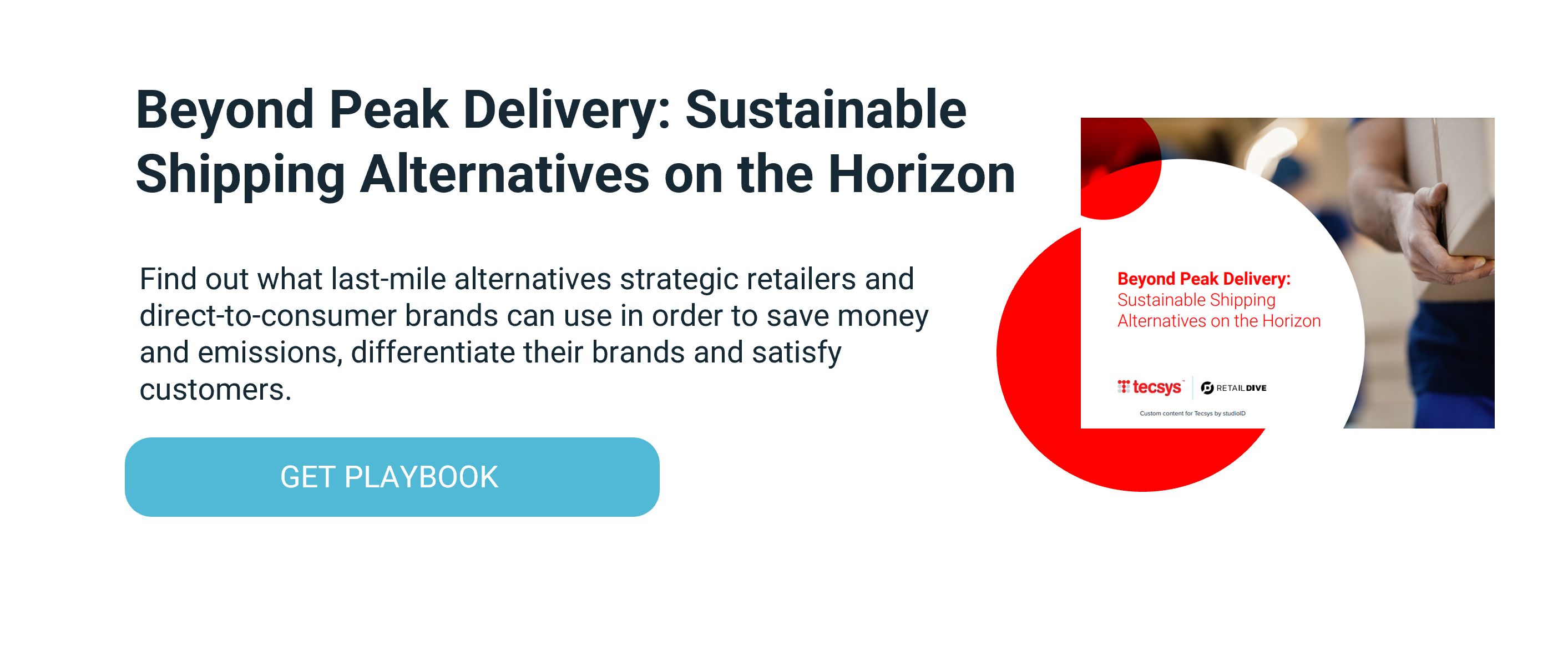The Next Wave of Sustainable Last-Mile Delivery Practices

Savvy retailers are implementing advanced strategies for sustainable last-mile deliveries to give customers options and better brand experiences. Gartner published a report predicting the demise of same-day and next-day deliveries. By 2025, the firm predicted, ongoing investments in rapid delivery will become valueless as customers reject rapid delivery for the majority of purchases.
As the Gartner report foreshadowed, these environmentally responsible retailers are likely recognizing there is no use in competing on speed and no value to be gained. With these early adopters already blazing the trail, the following practices are likely to become commonplace over the next three to five years.
5 Sustainable Last-Mile Delivery Practices
1. Order Consolidation
Getting multiple orders into one box is what the typical customer probably thinks of as order consolidation. In 2019, Target.com offered shoppers $1 off orders if they chose a slower shipping time that would allow for packing in fewer boxes. As a sustainable last-mile delivery practice, consolidated packing takes up less space in delivery vans, but the more important aspect of order consolidation is delivery density — having the time to ensure that no truck or van hits the road until it is fully loaded. That’s what generates the greatest emissions and cost savings. To execute order consolidation, a retailer needs to trust that today’s customers will agree to — and even benefit from — longer delivery windows but with fewer deliveries. They also need an order management system with a robust order routing rules engine to ensure that items located in different locations are efficiently routed to a pre-determined location and consolidated into one shipment for the end customer.
Learn more how order consolidation works and the benefits it can bring to your customers and your bottom line.
2. Store Fulfillment and Micro-fulfillment
Traditional retailers are beginning to fulfill online orders from their brick-and-mortar stores, or small and sometimes automated DCs located in population centers. When a customer places an order online, an employee at a store a few miles away may pick the item from the shelf or back inventory and then pack it and ship it with a local courier. With good inventory management, the environmental impact can be substantially lower than shipping the item from a distribution center halfway across the country. However, because distribution centers are inherently more efficient in packing and shipping, micro-fulfillment will require investments in systems and processes to be a sustainable last-mile delivery practice for retailers. However, it will enable in-store employees to perform the work more cost-effectively and reduce your environmental footprint.
Watch this six-minute video to understand the difference between micro-fulfillment vs. store fulfillment.
3. Order Routing
Consolidation, store fulfillment and micro-fulfillment can reduce the environmental impact and costs of shipping. But it requires sophisticated order routing to solve a complicated equation with many variables. Where is the customer? Where is the nearest distribution center or micro-fulfillment location? What are the associated emissions? What are the costs? What if they aren’t aligned? To solve the equation, retailers need the right data to set and balance priorities for environmental impact and profitability. Then those priorities must be translated into rules for an automated order-routing system to support sustainable last-mile delivery objectives.
Find out how to how to successfully execute order routing in an omnichannel world.
4. In-Store Pickup
Having a customer order online and drive to a local store to pick up the item can be a sustainable last-mile delivery practice which reduces costs and environmental impacts. But only if the item is already in the local store, it arrived there as part of a fully loaded truck, and it was picked and set aside by a store employee as part of an efficient process It’s both convenient and effective if the customer already makes regular shopping trips to the store, but it also runs the risk of being counter-effective — generating more road miles and emissions — if the item is simply rushed to the store in a half-empty truck and then the customer goes out of his or her way to drive to the store for pickup. Again, what the retailer needs is a collection of processes and a rules-based system to set the parameters on what delivery options are offered for single items or consolidated orders.
Watch and learn the four must-haves that are critical in crafting your buy online, pickup in-store (BOPIS) program in this three-minute video.
5. Owning the Last Mile
A growing number of retailers are beginning to manage their own deliveries, foregoing third-party couriers to offer more seamless, personalized customer experiences. With the use of electric vehicles and a transportation management system for scheduling and planning routes, owning the last mile can be a better value proposition for customers and an environmentally responsible mode of delivery.
Conclusion
Moving away from one-speed-fits-all delivery is undeniably complex. However, it’s achievable with the technology, data and experience on the market today, and in most industries, there’s still a first-mover advantage for the taking. Providing sustainable last-mile delivery options to e-commerce customers is not only necessary in response to worsening environmental and climate scenarios, but it’s also a smart, strategic way to balance the actual needs of customers with the financial needs of the business.




